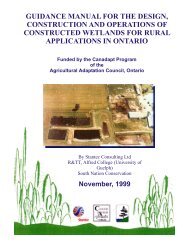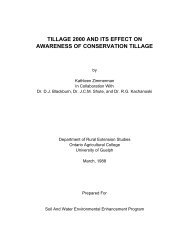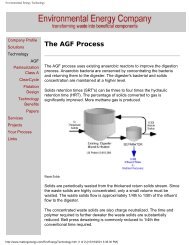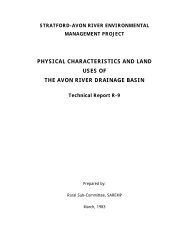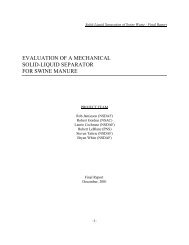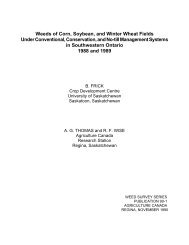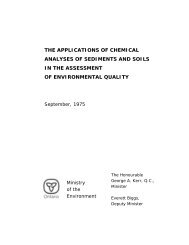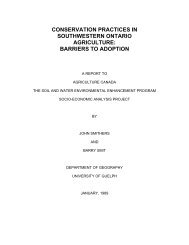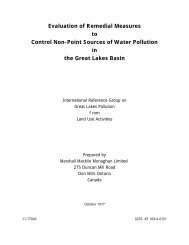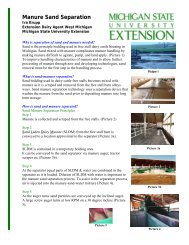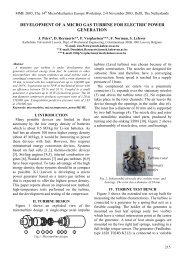Environmental Aspects of Phosphate and Potash Mining United ...
Environmental Aspects of Phosphate and Potash Mining United ...
Environmental Aspects of Phosphate and Potash Mining United ...
You also want an ePaper? Increase the reach of your titles
YUMPU automatically turns print PDFs into web optimized ePapers that Google loves.
<strong>Environmental</strong> <strong>Aspects</strong> <strong>of</strong> <strong>Phosphate</strong> <strong>and</strong> <strong>Potash</strong> <strong>Mining</strong><br />
1. Introduction<br />
1.1 The <strong>Mining</strong> <strong>of</strong> <strong>Phosphate</strong> Rock<br />
<strong>and</strong> <strong>Potash</strong> <strong>and</strong> the Environment<br />
Figure 1.1<br />
World mineral fertilizer production<br />
Fertilizers are a key factor in sustaining the world's<br />
agricultural output. They supply nutrients that are<br />
needed by all plants for normal growth, development<br />
<strong>and</strong> health. Maintaining an adequate supply <strong>of</strong> food<br />
for human consumption requires:<br />
A supplementary source <strong>of</strong> plant nutrients if the<br />
natural supply is insufficient.<br />
Replacement <strong>of</strong> the many possible nutrient losses.<br />
Ammonia<br />
<strong>Phosphate</strong><br />
rock<br />
<strong>Potash</strong><br />
Million tonnes nutrients<br />
120<br />
100<br />
80<br />
60<br />
40<br />
20<br />
These replacement <strong>and</strong>/or supplementary supplies<br />
can be provided through organic manures <strong>and</strong>/or<br />
mineral fertilizers.<br />
1990 to 2000<br />
0<br />
This publication concerns the provision <strong>of</strong> raw materials<br />
for two important mineral fertilizers, phosphate<br />
<strong>and</strong> potash.<br />
Three major nutrients are required in large quantities<br />
for plant growth, nitrogen, phosphorous <strong>and</strong> potassium.<br />
Three secondary nutrients are required in smaller<br />
quantities on some soils; sulfur, calcium <strong>and</strong> magnesium.<br />
Seven micronutrients may be required in small<br />
amounts where deficient. Each nutrient has a specific<br />
biological function <strong>and</strong>, while there may be synergies<br />
between the nutrients, none has a substitute.<br />
By far the most important for the present publication,<br />
in terms <strong>of</strong> the quantity mined <strong>and</strong> potential impact<br />
on the environment, are phosphate <strong>and</strong> potash.<br />
The production <strong>of</strong> phosphorous <strong>and</strong> potassium mineral<br />
fertilizers relies essentially on the mining <strong>of</strong><br />
mineral concentrations, in the form <strong>of</strong> ore deposits<br />
from the earth's crust. Nitrogen mineral fertilizers, on<br />
the other h<strong>and</strong>, are almost entirely based on ammonia<br />
manufactured from the abundant source <strong>of</strong> atmospheric<br />
nitrogen, water <strong>and</strong> energy.<br />
The production <strong>of</strong> nitrogen fertilizers has been discussed<br />
extensively in the earlier publication by<br />
UNEP/UNIDO/IFA on ‘Mineral Fertilizer Production<br />
<strong>and</strong> the Environment: Part 1 - The Fertilizer Industry's<br />
Manufacturing Processes <strong>and</strong> <strong>Environmental</strong> Issues’<br />
<strong>and</strong> will not be covered further here.<br />
World production <strong>of</strong> phosphorous <strong>and</strong> potassium<br />
mineral fertilizers in 1998/99 was 34 Mt P 2 O 5 (1) <strong>and</strong><br />
25.5 Mt K 2 O respectively. This required the extraction<br />
<strong>of</strong> 144 Mt <strong>of</strong> phosphate rock <strong>and</strong> more than 45 Mt <strong>of</strong><br />
potash ore (2). Table 1.1 indicates the scale <strong>of</strong> the mineral<br />
fertilizer raw material mining industry in<br />
comparison to the mining <strong>of</strong> other bulk mineral <strong>and</strong><br />
energy commodities.<br />
Table 1.1.<br />
Comparison <strong>of</strong> the World Production <strong>of</strong> Some<br />
Bulk Minerals in 1998/99<br />
Product<br />
Tonnage<br />
Coal 4,655,000,000<br />
Iron Ore 1,020,000,000<br />
Salt 186,000,000<br />
<strong>Phosphate</strong> Rock 144,000,000<br />
Bauxite 126,000,000<br />
Gypsum 107,000,000<br />
<strong>Potash</strong> Ore (2) 45,000,000<br />
(1) <strong>Phosphate</strong> <strong>and</strong> potash may be expressed as their elemental<br />
forms P <strong>and</strong> K, or as oxide forms P 2 O 5 <strong>and</strong> K 2 O. In this<br />
publication the oxide form is used.<br />
Mt = million tonnes<br />
(3) In KCl equivalent (sylvinite). Actual tonnages are larger,<br />
including kieiserite, langbeinite <strong>and</strong> carnallite ore.



